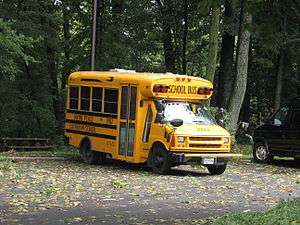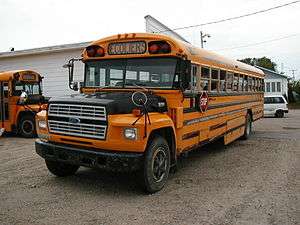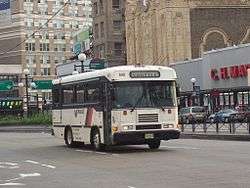Blue Bird Corporation
 | |
| Public | |
| Traded as | NASDAQ: BLBD |
| Industry | Bus manufacturing |
| Founded | 1932 |
| Founder | Albert L. Luce, Sr. |
| Headquarters |
402 Blue Bird Blvd P.O. Box 937 Fort Valley, GA 31030 |
Area served |
Over 60 countries worldwide
|
Key people | Phil Horlock, President and CEO |
| Products |
|
| Revenue |
|
|
| |
|
| |
Number of employees | 2,160 (2016)[2] |
| Parent |
|
| Website | Blue-Bird.com |
The Blue Bird Corporation (originally known as the Blue Bird Body Company) is an American bus manufacturer headquartered in Fort Valley, Georgia. Best known for as a manufacturer of school buses, the company has also manufactured a wide variety of other bus types, including transit buses, motorhomes, and specialty vehicles such as mobile libraries and mobile police command centers. Currently, Blue Bird concentrates its product lineup on school and activity buses and specialty vehicle derivatives.[4]
After company founder A.L. Luce produced a steel-panel school bus in his auto dealership in 1927, he started production of bus bodies exclusively in 1932, founding Blue Bird Body Company in Fort Valley, Georgia. Remaining under family control into the early 1990s, the company changed hands several times in the 2000s and became publicly owned in February 2015, with previous owner Cerberus Capital Management holding a 58% share of the company.
History
1927–1945: The Change to Steel

As the second quarter of the 20th century began, Albert Luce Sr. was one of the entrepreneurs of the period who transitioned from building wagons to developing some of the earliest purpose-built school buses. What is now Blue Bird Corporation began life as a side project in a Ford Motor Company dealership in Perry, Georgia.[5] Along with the dealership in Perry, Luce owned the Ford franchise in Fort Valley, Georgia, a rural farming community south of Macon.
In 1925, Luce had sold a customer a Ford Model T with a wooden bus body; the customer sought to use the bus to transport his workers. Due to a combination of unsatisfactory construction quality of the bus body and the rough conditions of the rural Georgia roads, the wooden bus body started to disintegrate before the customer had finished paying for the vehicle.[5][6] Driven to produce an improved design to sell to his customers, Luce sought input to develop a stronger bus body capable of surviving unimproved roads.[5] In place of wood, Luce constructed his bus body from steel and sheetmetal; wood was used as a secondary material.[6] Completed in 1927, the bus was put into use as a school bus.
While buses would initially remain a side project for Luce (with only 9 bus bodies produced between 1929 and 1931[5]), the onset of the Great Depression would make a change in his company forever. Following a 95% decline in car sales in 1931, Luce sold both of his Ford dealerships, using the $12,000 proceeds from the sale to begin his own company, concentrating solely on bus production.[5] Inspired to begin production in order to support the local economy, Luce also felt school buses would be a necessary resource as part of the shift towards consolidated schools.[5][7]
The early use of farm wagons on a part-time basis soon evolved into purpose-built school bus products, each with economy and function as major priorities. In 1937, the company began production of full-steel bus bodies, an innovation which soon replaced the wooden bodies which were then in common use around the United States.[7] In a 1939 conference, Blue Bird engineers helped to develop the color school bus yellow, which is still in use today.
During World War II, bus production was largely diverted to the armed forces, with Blue Bird producing buses and mobile ambulances. Due to rationing of steel, company engineers were forced to re-engineer several body assemblies to minimize use of steel.[5] By the end of the war, increased bus production lead Blue Bird school buses to come into use in many school districts in the Southern US outside of Georgia.[5]
1945–1960: Post-war transition
Following World War II, the configuration of schools throughout the United States continued to change. In rural communities, school districts transitioned away from schoolhouses towards centralized schools (sharing the graded class structures of urban schools) while urban populations moved into suburbs. Depending on location, the previous practice of walking to school had become increasingly impractical, particularly as students progressed into high school. In both rural and suburban school districts, the addition of the baby-boom generation lead to a new demand for school transportation.
Near the end of 1945, Blue Bird would see its factory in Fort Valley, Georgia destroyed by fire, forcing the company to build a new facility. Though the factory building was destroyed, a significant amount of equipment was salvaged, allowing bus production to resume shortly afterward.[5] In the post-war period, Blue Bird would grow substantially, becoming one of the larger body manufacturers in the United States. During the late 1950s, the leadership of Blue Bird changed. Company founder A.L. Luce retired, handing over operations to his three sons.[7]
All American
Blue Bird founder Albert Luce Sr. viewed a design for a flat-front passenger bus at the 1948 Paris Auto Show. Two years later, Blue Bird Body Company introduced their own transit-style design which evolved into the Blue Bird All American, often pointed to as one of the pioneer transit designs to gain widespread acceptance for school buses in North America, along with Wayne Corporation, Gillig Corporation and Crown Coach Corporation (whose "Supercoach" dated to 1932). In 1952, Blue Bird became the first school bus manufacturer to produce its own chassis rather than rely on outside suppliers for the All American; today, Blue Bird builds the chassis for every full-size bus produced.[8]
1960–1980: Moving beyond school buses

.jpg)
As the 1950s became the 1960s, Blue Bird grew rapidly, becoming the fourth-largest manufacturer of school buses.[7] To accommodate the added demand, the Luce brothers added several production facilities to supplement the Fort Valley, Georgia plant. In 1958, Blue Bird Canada was opened in Brantford, Ontario.[9] In 1962, Blue Bird Midwest was opened in Mount Pleasant, Iowa. In 1965, Blue Bird moved production beyond North America with Blue Bird Central America in Guatemala. To lower production and maintenance costs, while the Conventional and All American bodies were produced, they were built on locally sourced chassis (from Mercedes-Benz, Hino, Nissan Diesel, and Toyota).
Company founder A.L. Luce died in 1962. Shortly after, the three Luce sons sought to diversify the company product line, fearing that the school bus industry, whose demand was influenced by the baby boom generation, would eventually drop off as students completed their education. At the beginning of the decade, the Blue Bird company logo made its debut, painted on the roofline of many of its buses.
In 1963, the first major Blue Bird venture outside of school buses made its debut. Named the Blue Bird Transit Home (re-branded Wanderlodge in 1968), it was a $12,000 ($92,000 in 2015 dollars) luxury recreational vehicle based on the All American. Using the heavy-duty frame and all-steel body to its advantage, the vehicle was marketed as higher-quality than other RVs of the time; the interior was largely built to order. Based on the All American for over 25 years, the Wanderlodge developed a loyal following, including celebrities and heads of state among their owners.
In the 1970s, Blue Bird developed a bus for a much wider audience. Named the City Bird, it was a variant of the All American developed for the mass-transit segment. A short-wheelbase rear-engine bus, the City Bird was intended for smaller cities and routes with cul-de-sac ends, providing better maneuverability, and more efficient costs than larger vehicles.
During the 1970s, with the use of small school buses increasing, Blue Bird found a way to diversify its school bus line. While school buses based on cutaway vans were not invented by the company, Blue Bird found ways to gain significant market share. In 1975, Blue Bird introduced the Micro Bird, based on a dual rear-wheel Chevrolet/GMC van chassis. Largely similar to the Wayne Busette, the Micro Bird distinguished itself by featuring a full-height school bus door and additional windows forward of the entry door to aid loading-zone visibility. In 1977, the small-bus lineup was expanded to two with the debut of the Mini Bird, based on the GM P-30 stepvan chassis. While still a small bus in its own right, the Mini Bird was designed with the advantage of the same body width of the Conventional/All American; many Mini Birds were fitted with wheelchair lifts.
1980-2000: Market leadership

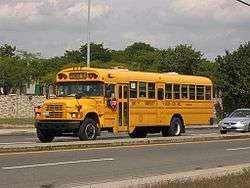
The late 1970s and early 1980s were a time of turmoil for school bus manufacturers; many of the predictions of the Luce brothers had largely come true. As the baby-boom generation completed their secondary education by the end of the 1970s, student populations, a key factor in school bus sales for nearly three decades, began to decline. Coupled with the fragile economy of the time, three of the six largest school bus manufacturers (Carpenter, Superior, and Ward) would file for bankruptcy in the early 1980s, with Superior exiting school bus production entirely. The recession of the early 1980s cut deeply into profits, leading to the re-organization or closure of several manufacturers. Blue Bird fared better than most competitors, becoming the largest manufacturer in terms of sales; by the mid-1980s, one out of every three new school buses was a Blue Bird.[7]
A key factor to the sales expansion was the renewal of the Blue Bird product line at the end of the decade. In 1988, the company made two product introductions that would change the company. Due to increasing demand, the company began in-house production of rear-engine chassis for the All American for the first time; previously, it was outsourced to other manufacturers. Also that year, the company expanded the transit-style school bus line from one to two with the introduction of the TC/2000. Largely a response to the Wayne Lifestar, the TC/2000 was developed in an effort to secure bids from operators of large fleets; it was designed with a purchase price nearly in line with conventional-style bus. However, unlike competitors, it was also designed with an in-house chassis like the All American. The TC/2000 was a runaway success; by 1990, nearly 1 in 10 new school buses was of the type. Introduced during 1989 production, Blue Bird made its first major changes to the All American since 1957. Along with major exterior updates, there was an all-new powertrain lineup and a redesigned drivers compartment.
While Blue Bird had enjoyed major success during the 1980s with school buses, the company had mixed results with its mass-transit products, discontinuing the City Bird in 1986 after 10 years of production. In 1992, Blue Bird launched the Q-Bus, a 96" wide bus transit and charter applications.[10] Unlike the City Bird, the Q-Bus was not based upon any version of the All American. During the 1990s, Blue Bird launched commercial versions of the All American and TC/2000, called the APC and CS-Series; the buses were also sold in shell versions for upfitters as well.
In the early 1990s, the Wanderlodge began to transition away from its school bus origins. While still a heavy-duty coach built largely to order, the Wanderlodge was redesigned to allow it to be built with a 102" wide body. While the width was illegal for a school bus, it had been allowed in motorcoaches (and some competing motorhomes) for some time. Additionally, the change allowed Blue Bird to modernize the looks of vehicle. In 1997, Blue Bird introduced its first passenger motorcoach, the LTC-40, its first passenger motorcoach; it became the donor platform for the Wanderlodge from 1998 onwards.
Environmentally-friendly buses
The 1990s were also a period that the company explored the use of alternative power sources for school buses. In 1991, Blue Bird introduced the first school bus (an All American Rear Engine) powered by compressed natural gas (CNG). In 1994, Blue Bird developed a battery-powered school bus in an effort with Westinghouse Electronic Systems for a school district in California.[7] While the electric school bus remained a prototype, Blue Bird has continued to offer CNG as an option on the All American since its 1991 introduction. In 1996,[11] the Envirobus 2000 concept made its debut; based loosely on the Q-Bus, it served as a testbed for both safety-related technology as well as the viability of compressed natural gas school buses.[12] In 2007, Blue Bird introduced a school bus fueled by propane autogas.[13]
Ownership changes and joint ventures
From its 1932 foundation until 1984, Blue Bird was run entirely by the Luce family, either by Albert Sr or by his three sons. In 1986, the board of directors hired Paul Glaske, president of Marathon LeTourneau, a Texas-based heavy equipment manufacturer.[7] During this time, the Luce family still maintained ownership of the company. In 1992, Merrill Lynch Capital Partners purchased an 82% stake of the company in a management-led buyout with the other 18% spread between Paul Glaske and 14 other Blue Bird managers.[7] After the buyout, the company name changed from Blue Bird Body Company to Blue Bird Corporation.
During the 1990s and early 2000s, declining demand for school buses and changes in world markets would lead to a number of changes at the company, leading to several ownership changes. In 1999, the British Henlys Group PLC purchased Blue Bird with a substantial financial stake held by Volvo Group.[14] The ownership changes during the late 1990s led to a number of changes in Blue Bird production facilities. In 1992, the factory in Buena Vista, Virginia (Blue Bird East) was shut down; in its place, the company opened its first factory in Mexico (Blue Bird de Mexico) in Monterrey, Nuevo León in 1995.
In 1992, in an effort to supplement its product line, Blue Bird entered into a supply agreement with its Canadian bus manufacturer Girardin Minibus (its distributor in the country) to supply dealers in the United States with the newly designed MB-II/MB-IV cutaway van (branded as Blue Birds). While similar to the Micro Bird, the Blue Bird MB-II/IV by Girardin allowed Blue Bird to offer an updated body design along with a configuration based on a single rear-wheel van chassis; at the time, Girardin was the only school bus manufacturer that built a full cutaway body for a single rear-wheel chassis. The MB-II/IV were sold by Blue Bird until 1999.
After redesigning its medium-duty truck line in 1991, General Motors entered into an 11-year supply agreement with Blue Bird, starting with 1992 production. Although the Blue Bird Conventional would remain available on other chassis (Ford, Navistar, and later Freightliner), the school bus version of the Chevrolet Kodiak/GMC TopKick would become the standard version of the Blue Bird Conventional, called the Blue Bird/GM CV200. The CV200 was produced until 2003.
2000s: Focus toward school buses

While the late 1990s were calmer than the late 1970s for the school bus industry, it still remained a time of relative turmoil for school bus manufacturers; this would carry into the 2000s. Several school bus manufacturers underwent acquisition or changed hands (AmTran and Thomas Built Buses); by 2001, several others (Crown Coach, Carpenter, Gillig, Wayne) would end school bus production forever. Instead of being family-run companies, school bus manufacturers were now owned by larger companies with ties to truck manufacturing. For Blue Bird, a large stake of the company was owned by the Volvo Group, the largest bus manufacturer in the world. However, during the early 2000s, due to financial difficulties of its other parent company, Blue Bird was sold from Henlys in 2004. In 2006, Blue Bird was acquired through a bankruptcy filing by Cerberus Capital Management.[15] Looking to develop its entries in the transportation sector, Blue Bird was paired with North American Bus Industries (NABI) and Optima Bus Corporation by Cerberus.
At the beginning of the 2000s, Blue Bird sought to modernize its aging transit bus line; the Q-Bus was nearly a decade old and the CS and APC coaches were essentially commercial versions of the All American and TC/2000 school buses. For 2002, the 96-inch wide Q-Bus was replaced by the 102-inch wide Xcel102 and the CS and APC lines were retired. In 2003, the company entered the low-floor segment with the introduction of the UltraLF and UltraLMB.
As the number of full-size school bus manufacturers had been cut from seven to three from 1990 to 2000, Blue Bird began on making its school bus products more competitive during the early part of the decade. Following the substantial update of the All American in 1999, Blue Bird discontinued the slow-selling TC/1000 in 2001 and consolidated the TC/2000 with the All American early in 2004.
However, the largest change came in 2003, as Blue Bird sought to replace the CV200. While initially developed to use the Ford F-650 Super Duty chassis, the Vision underwent a major change before its release. In a major break from precedent, Blue Bird did not use an existing truck manufacturer for the chassis, instead developing its own version from the ground up. While the Vision used the same bus body as the long-running Conventional, engineering changes were made to optimize forward visibility.
As part of its acquisition by Cerberus, Blue Bird gradually saw itself positioned exclusively into yellow school bus production, its largest market. In 2007, the Xcel102 was discontinued and the low-floor UltraLF/LMB product lines were added to NABI. In a controversial move, the rights to the Wanderlodge luxury motorhome were sold to Complete Coach Works; production ended in 2009.
In commemoration of the 80th anniversary of the construction the first Blue Bird bus and the centennial of the Model T Ford, the Luce family donated the restored vehicle to The Henry Ford Museum in 2008.[6][16] Dubbed "Blue Bird #1", it is the oldest known surviving school bus in the United States.
With resources dedicated solely towards school bus production, the Vision saw a major update for 2008. In addition to a new dashboard, it received a new cowl with larger headlights and grille. For 2009, the company expanded alternative-fuel options as it introduced a propane-fuel variant of the Vision; it was powered by a General Motors 8.1L V8. For 2010, the All American was given a complete update, marking some of the largest changes to the Blue Bird body design in over 50 years; along with a complete redesign of the roof, windshield, and rear entry, the interior received a ground-up redesign.
With the streamlining of bus production, the number of production facilities utilized by the company has been reduced. Blue Bird de Mexico was closed in 2001 and Blue Bird Midwest in Mount Pleasant, Iowa was closed in 2002.[17] In 2010, Blue Bird North Georgia was closed, consolidating all bus production back to company headquarters in Fort Valley.
In October 2009, Blue Bird further streamlined its bus production as it entered into a second joint venture with Canadian school bus manufacturer Girardin Minibus.[18] Dubbed Micro Bird, Inc., all small bus production was consolidated at the Girardin facilities in Quebec, Canada; consequently, all Blue Bird production is now limited to full-size conventional and transit buses. The 2010 Micro Bird was the last Blue Bird bus to use a non-Blue Bird chassis.
2010-present: Next-generation school buses

_(2).jpg)
Following the consolidation of Blue Bird production to the Vision and All American school buses (and vehicles derived from them), during the 2010s, a number of changes were phased in. In following with the popularity with the LPG/propane autogas version of the Blue Bird Vision bus, a version powered by a Ford V10 and equipped with a ROUSH CleanTech propane autogas fuel system was introduced in 2011 (as the original General Motors V8 engines were no longer in production); in addition, the Vision received a dashboard and steering column shared with the All American.
In late 2012, Blue Bird unveiled a redesigned 2014 All American series (code-named the T3 Series), which would replace versions introduced in 1999 and 2008 produced concurrently. Distinguished by a redesigned (rounder) roof, the new All American has increased parts commonality with the Vision. In October 2013, the 2015 Vision was introduced. Along with clear-lens headlights and a new grille, propane-fueled versions gained the option of an extended-range 98-gallon fuel tank. Company owner Cerberus Capital sold off the majority of its transportation holdings, including NABI and Optima to Canadian bus builder New Flyer; Blue Bird remained under Cerberus ownership.
In late 2013, Blue Bird entered a different segment of school transportation as it introduced Blue Bird Connect™, a GPS-based fleet management software system co-developed with Synovia Solutions. While designed as an integrated system as an option for any Blue Blue school bus, Blue Bird Connect™ was also intended for retrofit to existing fleets of school buses as well, regardless of brand.[19]
Though produced by Girardin under the Micro Bird joint venture, in late 2014, the company introduced the Micro Bird T-Series, a Girardin-bodied Type A school bus; it is the first school bus body ever produced for the Ford Transit in North America.[20] Largely due to the Ford-derived chassis design, Blue Bird predicts a 20% fuel economy increase over its E-Series MB/G5 counterpart.[20]
In September 2014, the ownership of Blue Bird underwent another transition. Texas-based venture capital firm Hennessy Capital Acquisition Corporation purchased a $255 million stake of the company from Cerberus affiliate The Traxis Group.[21] As part of the acquisition, Cerberus/Traxis would retain majority ownership; the Blue Bird leadership team remained in place.[21] Although Cerberus remains the majority owner of Blue Bird with a 58% share of the company, in late February 2015, Blue Bird became the first stand-alone school bus manufacturer to become publicly traded on NASDAQ.[22]
By 2015, Blue Bird ranked as the leading provider of proapne autogas powered school buses through a partnership with ROUSH CleanTech, which provides propane autogas fuel systems for the buses. [23]At this time, the Propane Education & Research Council (PERC) estimated that between school districts and private fleets, 11,000 propane school buses had been purchased in the United States.[24]
In September 2015, Blue Bird further expanded its non-diesel fuel offerings as the company introduced a gasoline-fueled variant of the Vision, starting with 2016 production[25] The first gasoline-fueled full-size school bus since the discontinuation of the 2002 Blue Bird CV200, it is powered by the same Ford V10 used by the propane-fueled variant of the Vision.
In January 2017, Blue Bird announced it would begin development of a Zero Emission Vehicle (ZEV) school bus with the Vehicle-to-Grid (V2G) technology. This development work is being supported by a $4.4 million grant from the U.S. Department of Energy, as well as additional support from other entities, bringing together just over $9 million in funds. The project will result in eight ZEV V2G school buses being deployed in California. [26]
Products
In addition to school, activity, and commercial applications, Blue Bird buses have been custom-built for unique applications such as bloodmobiles, mobile libraries, and public safety command centers.
School buses
| Current Product Line | |||
|---|---|---|---|
| Model Name | Micro Bird by Girardin | Vision | All American (T3) |
| Photo | 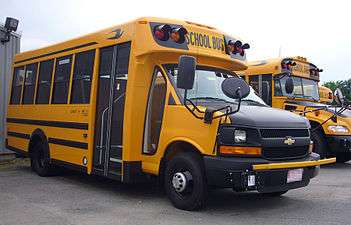 |
 |
|
| Year Introduced | 2010 | 2003 | 1948 |
| Assembly | Drummondville, Quebec, Canada | Fort Valley, Georgia | |
| Configuration |
Type A MB-II:single rear wheel G5:dual rear wheel T-Series: single/dual rear wheel |
Type C |
Type D (front engine, rear engine) |
| Chassis Manufacturer | Ford Motor Company
Ford E-350/E-450 (2010-2014) Ford Transit (2015-on) General Motors |
Blue Bird | |
| Fuel Type(s) |
Gasoline, Diesel, Propane |
Gasoline, Diesel, Propane, Compressed Natural Gas (CNG) |
Diesel, Compressed Natural Gas (CNG) |
| Passenger Capacity | 10-30 | 36-77 | 54-90 |
| Other Notes |
|
|
|
| Former Product Lines | |||||
|---|---|---|---|---|---|
| Model Name | Years Produced | Assembly | Configuration | Chassis Supplier | Notes |
| Micro Bird
|
1975–2010 |
|
Type A
(single or dual rear wheel) |
Ford Motor Company
Ford Econoline/E-Series General Motors Chevrolet Express (1997–present) Chevrolet G-30/GMC Vandura (1975–1996) Chevrolet P-30 (1995–1996) |
|
| MB-II/MB-IV
|
1992–1999 | Drummondville, Quebec, Canada | Type A
|
Ford Motor Company
Ford Econoline/E-Series (1992–1999) General Motors Chevrolet Express/GMC Savana (1997–1999) Chevrolet G-30/GMC Vandura (1992–1996) |
|
| Mini Bird
|
1977–2005 |
|
Type B | General Motors
Chevrolet P30 |
|
| Conventional
|
c.1957-2004 |
|
Type C | Chrysler Corporation
Dodge D-300 (to 1977) DaimlerChrysler Corporation Freightliner FS-65 (1997–2002) Ford Motor Company Ford B600/B700/B800/B8000 (to 1998) General Motors Chevrolet/GMC B-Series (1966–1991) International Harvester Loadstar 1703 (1962–1978) S-1700/S1800 (1979–1989) Navistar International International 3800 (1989–2004) |
The Conventional uses a cowled-chassis version of the body used by the All American (except for the D3 Series) and the TC/2000. Available on a wide variety of commercially produced chassis, discontinued with the end of International 3800 production in 2004.
Replaced by Blue Bird Vision. In export markets, the Conventional was often produced using locally sourced chassis. |
Chevrolet/GMC CV200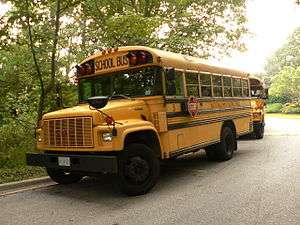 |
1992-2003 |
|
Type C | General Motors | Produced under a supply agreement between Blue Bird and General Motors; the Chevrolet/GMC chassis was used exclusively by the company. Ford, Freightliner, Navistar versions of the Conventionals were produced as options.
The 2003 CV200 was the last full-sized C school bus (prior to 2016) available with a gasoline engine. CV200 was replaced by the Vision. |
SBCV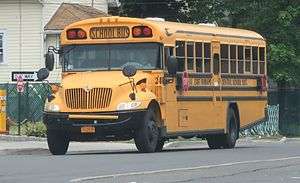 |
2005-2008 |
|
Type C | Navistar International | The SBCV was the replacement for the Conventional based on the International 3800; Blue Bird is the only body manufacturer to use the International 3300 chassis besides IC Bus.
Produced alongside Vision until its 2008 discontinuation. |
| TC/1000 | 1997–2001 | Type D
front engine |
Blue Bird Corporation |
| |
| TC/2000
|
1988–2003 |
|
front engine rear engine |
| |
Other vehicles
| Other Product Lines | |||
|---|---|---|---|
| Model | Production | Configuration | Notes |
| City Bird | 1976-1986 | High-floor, rear engine | Short-wheelbase adaptation of All American for the mass-transit market |
| CS-Series APC-Series
|
1990s-2002 | High-floor, front and rear engine | Various versions of the All American and TC/2000 school bus body and chassis adapted for commercial use.[29][30] The CS-Series was marketed towards transit and shuttle use while the APC was marketed towards various commercial buyers. |
| Q-Bus | 1992-2001[10] | High-floor, rear engine | Mass-transit bus introduced in 1992 as the replacement for the City Bird. First Blue bird transit bus not based upon the All American or TC/2000. |
| Xcel102 | 2002-2007 | High-floor, rear engine | Replaced Q-Bus First 102-inch wide Blue Bird transit bus. |
| Ultra LF Ultra LMB  |
2003-2010 | Low-floor, rear engine | First low-floor bus designed by Blue Bird. Built by NABI in Anniston, Alabama from 2007-2010. |
| LTC-40 | 1997-2003 | Rear-engine motorcoach | LTC=Luxury Touring Coach The LTC-40 was the first motorcoach designed by Blue Bird. From 1998 onwards, the LTC formed the basis for the Wanderlodge motorhome. |
Wanderlodge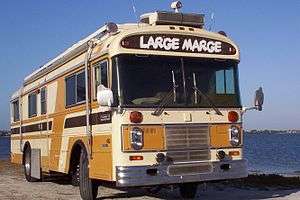 |
1963-2009 | Recreational vehicle, front or rear-engine | The Wanderlodge was a hand-crafted recreational vehicle available in several configurations Based on the All American school bus from 1963-1989 Rights to product line sold to Complete Coach Works in 2007; production ceased in 2009. |
| Blue Bird Sigma | 2014 | Transit Bus, front or rear-engine | The Sigma is a new Transit Bus produced by Bluebird starting in 2014. |
Exports
Blue Bird have also built a number of buses for the United Kingdom market, with 62 Blue Bird buses being exported to the UK between 1992 and 2007. Most of the vehicles exported were right hand drive variants of the Blue Bird All American and the Blue Bird Q-Bus. Various local councils, such as Staffordshire County Council and West Sussex County Council, imported a large number of Blue Bird school buses for their own school routes; FirstGroup were the largest private customer in the United Kingdom, ordering eighteen All Americans in 2002.[31]
In addition to school buses, a single low-floor city bus, known as the Blue Bird LFCC9, was built in late 2003. The 29-seater midibus, registered NK53TJV, received the then-popular Plaxton Pointer 2 bodywork and entered service with Arriva North East.[32]
Prototypes
| Model | Year | Chassis (Configuration) | Notes |
|---|---|---|---|
| Envirobus 2000 | 1996[11] | Blue Bird Q-Bus (rear-engine) | Loosely based on the Q-Bus, the Envirobus 2000 served as a testbed for the viability for compressed natural gas (CNG) in large-scale production for school buses.[12] A number of advanced safety features were integrated as part of the design. The Envirobus was not intended for production in its prototype form. |
| Blue Bird/Ford Conventional | 2002 | Ford F-750 Super Duty (conventional, cowled chassis) | As Blue Bird sought to replace the General Motors-chassis CV200 after 2003, several Blue Bird Conventional bodies were fitted on F-750 Super Duty chassis as a potential replacement. As Ford never completed a supply agreement with Blue Bird, these would become the very last Ford-chassis school buses ever built.
Several features of these prototypes were integrated into the Vision introduced in 2003.[33] |
| EC-72 | 2006 | Blue Bird Vision (conventional, cowled chassis) | Using the chassis of the Vision, the EC-72 was a limited-production series of conventional prototypes intended for testing new production designs; the EC-72 used the hood later seen on the 2008-2014 Vision along with a new roof and window design. Approximately 50 were produced in total. |
Company timeline
| Blue Bird Corporation Timeline, 1970–present | ||||||||||||||||||||||||||||||||||||||||||||||||||||||||||||||||||||||||||||||||||||
| Buses (by configuration) |
1970s | 1980s | 1990s | 2000s | 2010s | |||||||||||||||||||||||||||||||||||||||||||||||||||||||||||||||||||||||||||||||
| '70 | '71 | '72 | '73 | '74 | '75 | '76 | '77 | '78 | '79 | '80 | '81 | '82 | '83 | '84 | '85 | '86 | '87 | '88 | '89 | '90 | '91 | '92 | '93 | '94 | '95 | '96 | '97 | '98 | '99 | '00 | '01 | '02 | '03 | '04 | '05 | '06 | '07 | '08 | '09 | '10 | '11 | '12 | '13 | '14 | '15 | '16 | '17 | |||||||||||||||||||||||||||||||||||||
| Company Ownership | A.L. Luce family | Merrill Lynch Capital | Henlys plc | Peach County Holdings |
Cerberus Capital | Publicly Traded (Cerberus Majority owner) | ||||||||||||||||||||||||||||||||||||||||||||||||||||||||||||||||||||||||||||||
| Type A | ||||||||||||||||||||||||||||||||||||||||||||||||||||||||||||||||||||||||||||||||||||
| Single rear-wheel | MB-II by Girardin | Micro Bird SRW | Micro Bird MB-II | |||||||||||||||||||||||||||||||||||||||||||||||||||||||||||||||||||||||||||||||||
| Micro Bird T-Series | ||||||||||||||||||||||||||||||||||||||||||||||||||||||||||||||||||||||||||||||||||||
| Dual rear-wheel | Micro Bird (DRW) | Micro Bird T-Series DRW | ||||||||||||||||||||||||||||||||||||||||||||||||||||||||||||||||||||||||||||||||||
| MB-IV by Girardin | Micro Bird G5 | |||||||||||||||||||||||||||||||||||||||||||||||||||||||||||||||||||||||||||||||||||
| Type B | Mini Bird | |||||||||||||||||||||||||||||||||||||||||||||||||||||||||||||||||||||||||||||||||||
| Type C | Conventional | SBCV | ||||||||||||||||||||||||||||||||||||||||||||||||||||||||||||||||||||||||||||||||||
| CV200 | Vision | Vision | Vision | |||||||||||||||||||||||||||||||||||||||||||||||||||||||||||||||||||||||||||||||||
| Type D | All American Forward Engine (1957) | All American Forward Engine (1989) | All American (A3FE) | All American (T3FE/T3RE) | ||||||||||||||||||||||||||||||||||||||||||||||||||||||||||||||||||||||||||||||||
| All American Rear Engine (various chassis) |
AARE (Blue Bird) | All American Rear Engine (1989) | All American (A3RE) | All American (D3RE/D3FE) | ||||||||||||||||||||||||||||||||||||||||||||||||||||||||||||||||||||||||||||||||
| TC/2000 Forward Engine |
TC/2000 Forward Engine |
TC/2000 Forward Engine |
||||||||||||||||||||||||||||||||||||||||||||||||||||||||||||||||||||||||||||||||||
| TC/2000 Rear Engine |
TC/2000 Rear Engine |
|||||||||||||||||||||||||||||||||||||||||||||||||||||||||||||||||||||||||||||||||||
| TC/1000 | ||||||||||||||||||||||||||||||||||||||||||||||||||||||||||||||||||||||||||||||||||||
| Non-School Buses | City Bird | Q-Bus | Xcel102 | |||||||||||||||||||||||||||||||||||||||||||||||||||||||||||||||||||||||||||||||||
| CS-Series | ||||||||||||||||||||||||||||||||||||||||||||||||||||||||||||||||||||||||||||||||||||
| Ultra LF/Ultra LMB | ||||||||||||||||||||||||||||||||||||||||||||||||||||||||||||||||||||||||||||||||||||
| LTC-40 | ||||||||||||||||||||||||||||||||||||||||||||||||||||||||||||||||||||||||||||||||||||
| Wanderlodge (96" body) | Wanderlodge (102" body) | Wanderlodge LX/LXi/M380 | ||||||||||||||||||||||||||||||||||||||||||||||||||||||||||||||||||||||||||||||||||
Manufacturing and assembly
Traditionally, school buses such as those produced by Blue Bird consist of components purchased from various outside suppliers and parts which are manufactured in-house to the company's specifications. These two categories of parts are then typically assembled into bodies which can be mounted onto chassis which have often been variations of those used in a myriad of truck applications.
Production-wise, the large "home" plant complex in Fort Valley, Georgia served as both a part manufacturing plant for the entire organization as well as one of the six locations where bodies were assembled from in house and purchased components. Parts and service were also located in Fort Valley, as was Wanderlodge Wayside Park, a tree-shaded motor home park for visiting Wanderlodges adjacent to the Wanderlodge plant.
Blue Bird Corporation currently operates a single manufacturing facility in the United States: the Blue Bird Body Company in Fort Valley, Georgia. A second facility (Blue Bird North Georgia) in LaFayette, Georgia was closed August 30, 2010.[34]
In the past, Blue Bird has had an international manufacturing presence, with two factories in Canada, one in Mexico, and one in South America. These have now all been closed due to changing market conditions and Blue Bird's shift back to a lineup of school bus-based vehicles.
| Blue Bird Corporation Manufacturing Facilities | |||||
|---|---|---|---|---|---|
| Name | Location | Product Lines | Year Opened | Year Closed | Notes |
| United States | |||||
| Blue Bird Body Company | Fort Valley, Georgia |
|
See Notes |
| |
| Blue Bird North Georgia | LaFayette, Georgia |
|
1988 | 2010 | Closed August 30, 2010.[35] |
| Blue Bird Midwest | Mount Pleasant, Iowa |
|
1962 | 2002 | |
| Blue Bird East | Buena Vista, Virginia |
|
1972 | 1992 | |
| Blue Bird Wanderlodge | Fort Valley, Georgia |
|
1963 | 2007 | Originally opened as Cardinal Manufacturing |
| Canada | |||||
| Blue Bird Canada | Brantford, Ontario, Canada |
|
1958 | 2007 | Blue Bird also operated a facility in St. Lin, Quebec from 1975 to 1982 |
| Micro Bird, Inc. | Drummondville, Quebec, Canada | Micro Bird (MB-II, G5) | 1981 | Girardin Minibus production facility | |
| Worldwide Facilities | |||||
| Blue Bird de Mexico | Monterrey, Nuevo León, Mexico |
|
1995 | 2001 | |
| Blue Bird Central America | Guatemala City, Guatemala | See Notes | 1965 | 1980s | Produced All American and Conventional bodies on locally available chassis. |
Branding

The Blue Bird company emblem, painted on the roof of many of its buses since the early 1960s, is a silhouette profile of its namesake, a bluebird.
Although the origin of the company name is no longer known, several theories are known to exist. Most commonly, in the early 1930s, A.L. Luce was perceived to have been nervous about using the family surname for the company out of fears of it being mispronounced (i.e., "the loose bus").[5][7] When showing a blue and yellow demonstrator unit to school officials, Luce overheard the positive reception of school children who had seen the bus, who had nicknamed it "a pretty blue bird"; Luce chose that name for his body manufacturing company, though school buses are painted yellow today.[5]
Images
 2000s Blue Bird All American FE bus in transit service in Bronx, NY.
2000s Blue Bird All American FE bus in transit service in Bronx, NY. 1990s Blue Bird/GMC as a mobile firefighting command center in Quebec.
1990s Blue Bird/GMC as a mobile firefighting command center in Quebec. Right hand drive Blue Bird TC/3000 in use with First Essex in Essex, UK.
Right hand drive Blue Bird TC/3000 in use with First Essex in Essex, UK.- Defunct 1997 Blue Bird wheelchair-equipped bus with International 3800 chassis in Kentucky.
See also
| Wikimedia Commons has media related to Blue Bird buses. |
References
- ↑ "Blue Bird Corporation". Retrieved 2010-10-18.
- 1 2 3 4 https://finance.yahoo.com/quote/BLBD/financials?p=BLBD
- ↑ Traxis Group
- ↑ http://www.blue-bird.com Blue Bird Corporation
- 1 2 3 4 5 6 7 8 9 10 11 "Blue Bird, School Bus, History, Blue Bird Body Co., Blue Bird Corp., Wanderlodge, Buddy Luce, Albert L. Luce, Cardinal Mfg., Fort Valley, Georgia - CoachBuilt.com". www.coachbuilt.com. Retrieved 2016-06-05.
- 1 2 3 McKeegan, Noel (March 9, 2008). "First steel-bodied school bus donated to Henry Ford museum". gizmag.com. Retrieved 30 November 2013.
- 1 2 3 4 5 6 7 8 9 "History of Blue Bird Corporation – FundingUniverse". Fundinguniverse.com. Retrieved 2012-10-29.
- ↑ "Blue Bird Corporation/About Us/History". Archived from the original on 2011-07-08. Retrieved 2010-01-11.
- ↑ Blue Bird Corporation To Relocate Micro Bird Production; Blue Bird Press Release, May 8, 2007
- 1 2 http://www.secinfo.com/dRqWm.82F7.htm#d4p Blue Bird Body Co. 1996 10-K405 Annual Report -- [X] Reg. S-K Item 405
- 1 2 http://www.afdc.energy.gov/pdfs/suc2.pdf
- 1 2 "Blue Bird Envirobus 2000 School Bus". Blue Bird Corporation via http://web.archive.org. Archived from the original on 1998-05-19. Retrieved 2010-07-10. External link in
|publisher=(help) Archived version of Blue Bird's website on this vehicle, with link to specifications. - ↑ "Let's Talk Propane Autogas: Best Practices in the School Bus Industry" (PDF). www.westernbus.com.
- ↑ "Volvo Group; Volvo Logistics North America". Volvo.com. Retrieved 2009-08-10.
- ↑ "Blue Bird Corporation/About Us/History". Archived from the original on 2011-07-08. Retrieved 2010-01-09.
- ↑ "School Bus Fleet News, Blue Bird No. 1 donated to historical institution, March 10, 2008". Schoolbusfleet.com. 2008-03-10. Retrieved 2009-08-10.
- ↑ Osborne, Alistair (2001-09-07). "Telegraph.co.uk; Henlys takes a skid after US bus sales fall". Telegraph.co.uk. Retrieved 2009-08-10.
- ↑ "Press Releases/BLUE BIRD AND GIRARDIN ANNOUNCE JOINT VENTURE(2009-10-19)" (Press release). Archived from the original on 2010-07-24. Retrieved 2010-01-17.
- ↑ "Blue Bird Connect" (PDF). Retrieved 1 February 2014.
- 1 2 "THE NEW MICRO BIRD T-SERIES BUS LINE DEBUTS AT NAPT". Retrieved 4 December 2014.
- 1 2 "Blue Bird to be acquired, will be publicly traded company". Retrieved 1 March 2015.
- ↑ "Blue Bird becomes publicly traded company". Retrieved 1 March 2015.
- ↑ "Blue Bird Bus Is Now a Public Company | Fleets and Fuels.com". www.fleetsandfuels.com. Retrieved 2017-07-31.
- ↑ "Exploring the rise in propane school bus sales". LP Gas. 2016-10-12. Retrieved 2017-07-31.
- ↑ "Blue Bird Unveils New Gasoline-Powered Type C Vision School Bus". Retrieved 26 December 2015.
- ↑ "Blue Bird Awarded $4.4 Million to Develop Electric School Bus | News | Press Releases | blue-bird". www.blue-bird.com. Retrieved 2017-02-01.
- ↑ "Autobus Girardin - Minibus (Specialized bus) Used minibus | Autobus Girardin (School bus) Girardin Minibus". Girardinbluebird.com. 2009-05-23. Retrieved 2009-08-10.
- ↑ "Girardin; A Brief History". Autobusgirardin.com. Retrieved 2009-08-10.
- ↑ "Blue Bird | Commercial | CS Buses". Archived from the original on May 19, 1998. Retrieved 10 December 2014.
- ↑ "Blue Bird | Commercial | APC Series". Archived from the original on May 19, 1998. Retrieved 10 December 2014.
- ↑ http://buslistsontheweb.co.uk/
- ↑ http://buslistsontheweb.co.uk/
- ↑ "School Bus Central- 2002 Blue Bird/Ford". Retrieved 2010-07-10. Webpage with archived version of product literature
- ↑ LaFayette Blue Bird bus plant being shut down; Chattanooga Times-Free Press; June 24, 2010
- ↑ "Press Releases". Blue Bird Corporation. Archived from the original on 24 July 2010. Retrieved 25 June 2010.
External links
- Blue-Bird.com Blue Bird Corporation official website
- Blue Bird Corporation official Facebook Page
- Blue Bird Corporation official Twitter Page
- School Bus Fleet magazine official website
- Federal Motor Vehicle Safety Standards (FMVSS) for school buses
- U.S. Bureau of Transportation Statistics
- Technical support forum for the Blue Bird Wanderlodge
